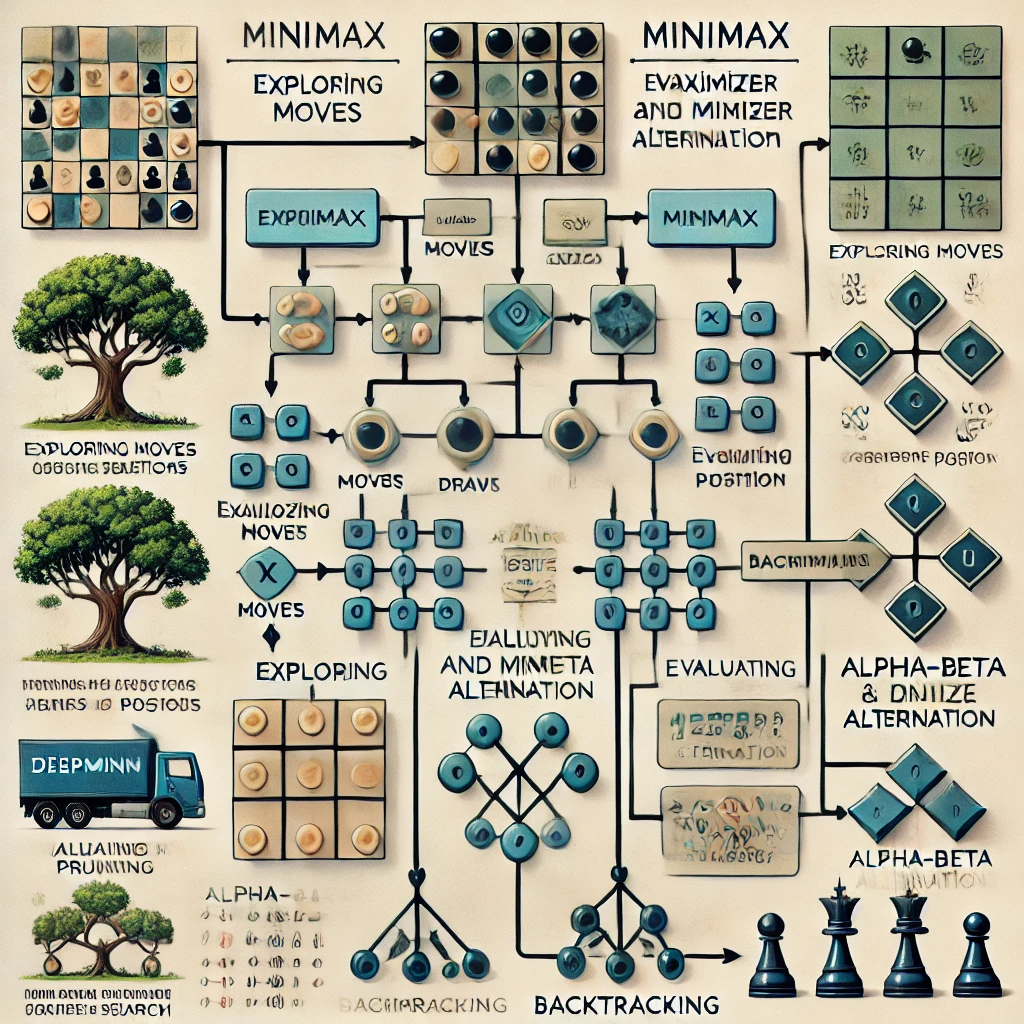The Minimax algorithm is a fundamental decision-making technique widely used in artificial intelligence, especially in the domain of two-player, turn-based games like chess, tic-tac-toe, and Go. It provides a strategy for determining the optimal move for a player, assuming that the opponent is also playing optimally. This article delves into the key aspects of the Minimax algorithm and explores recent developments in its application.
The Essence of the Minimax Algorithm
At its core, the Minimax algorithm operates under the assumption that both players are rational and will make the best possible moves to maximize their chances of winning. The algorithm’s primary goal is to minimize the possible loss in a worst-case scenario. Here’s how it works:
1. Exploring Possibilities: The algorithm generates a game tree by exploring all possible moves from the current state. Each node in the tree represents a game state resulting from a move.
2. Evaluating Positions: An evaluation function assigns a numerical value to each terminal node (end game state) of the tree. This value reflects how favorable the game state is for the player.
3. Alternating Perspectives: The algorithm simulates both players alternately. One player aims to maximize the evaluation function’s value (the maximizer), while the other aims to minimize it (the minimizer).
4. Backtracking: Starting from the terminal nodes, the algorithm backtracks through the tree, choosing the move that leads to the best possible outcome for the player at each decision point.
By systematically considering all possible moves and counter-moves, the Minimax algorithm ensures that the selected strategy is optimal against an equally skilled opponent.
Key Components of the Minimax Algorithm
Understanding the Minimax algorithm requires a closer look at its critical components:
1. Evaluation Function
The evaluation function is crucial for assessing the desirability of a game state when the game does not end in a win, loss, or draw. It quantifies the advantage of one player over the other based on factors like material count in chess or potential winning lines in tic-tac-toe. Designing an effective evaluation function is essential for the algorithm’s performance.
2. Recursive Exploration
The Minimax algorithm uses recursion to explore the game tree. At each node, it recursively evaluates the child nodes to determine the best possible move. This approach allows the algorithm to handle complex game trees with numerous possible states.
3. Depth-First Search (DFS)
A depth-first search strategy is employed to traverse the game tree. DFS explores as far down a branch as possible before backtracking. This method is memory-efficient since it requires storing only a path from the root to a leaf node rather than the entire breadth of the tree.
4. Backtracking and Move Selection
After evaluating the terminal nodes, the algorithm backtracks to the root node, selecting moves that lead to the best outcomes based on the evaluation function. The maximizer selects the move with the highest value, while the minimizer selects the move with the lowest value.
Recent Developments and Applications
While the fundamental principles of the Minimax algorithm have remained consistent, recent advancements have enhanced its efficiency and broadened its applications.
1. AlphaZero and Advanced Game Playing
DeepMind’s AlphaZero has demonstrated remarkable success in mastering games like chess, Go, and shogi. Unlike traditional Minimax implementations, AlphaZero combines deep neural networks with advanced search techniques, including a variation of Minimax known as Monte Carlo Tree Search (MCTS). This hybrid approach allows it to evaluate positions more effectively and handle the immense complexity of these games.
2. Enhanced Pruning Techniques
Optimizing the Minimax algorithm involves reducing the number of nodes that need to be evaluated. Alpha-beta pruning is a well-known technique that eliminates branches that cannot possibly affect the final decision. Recent research has introduced more sophisticated pruning methods, further reducing computational requirements and enabling the algorithm to look deeper into the game tree within practical time constraints.
3. Applications in Robotics
In robotics, the Minimax algorithm is being adapted for decision-making in adversarial environments, such as robotic soccer or competitive obstacle courses. Robots use the algorithm to anticipate and counteract the actions of opposing robots, enhancing their ability to perform in dynamic, competitive settings.
4. Integration with Machine Learning
Combining the Minimax algorithm with machine learning techniques has led to more powerful AI systems. Machine learning models can improve the evaluation function by learning from vast amounts of data, enabling the algorithm to make more informed decisions. This integration is particularly effective in games and scenarios where handcrafted evaluation functions are insufficient.
5. Cybersecurity Applications
In cybersecurity, the Minimax algorithm models the interaction between attackers and defenders. By anticipating potential attack strategies, security systems can devise defense mechanisms that minimize the potential damage. This adversarial approach is crucial in developing robust security protocols and intrusion detection systems.
Conclusion
The Minimax algorithm remains a cornerstone in artificial intelligence for strategic decision-making in competitive environments. Its ability to model and anticipate an opponent’s moves makes it invaluable in game theory and beyond. Recent advancements have not only improved its efficiency but have also expanded its applicability to fields like robotics and cybersecurity. As AI continues to evolve, the Minimax algorithm and its derivatives will undoubtedly play a significant role in developing intelligent, strategic systems.


